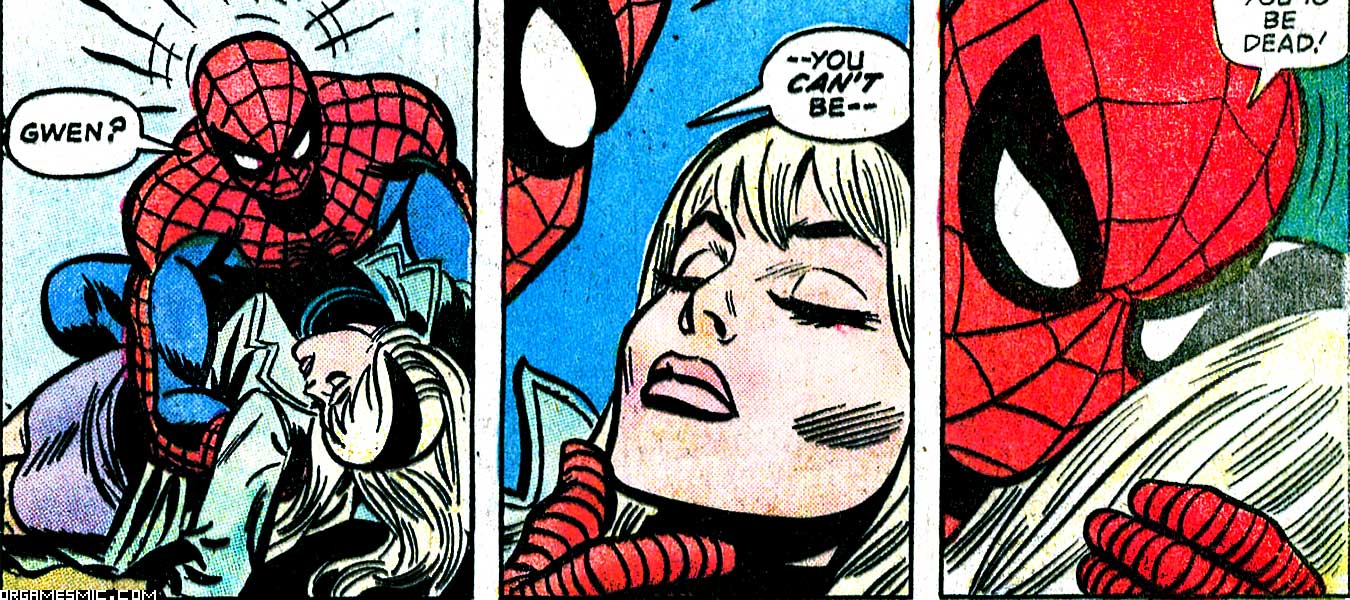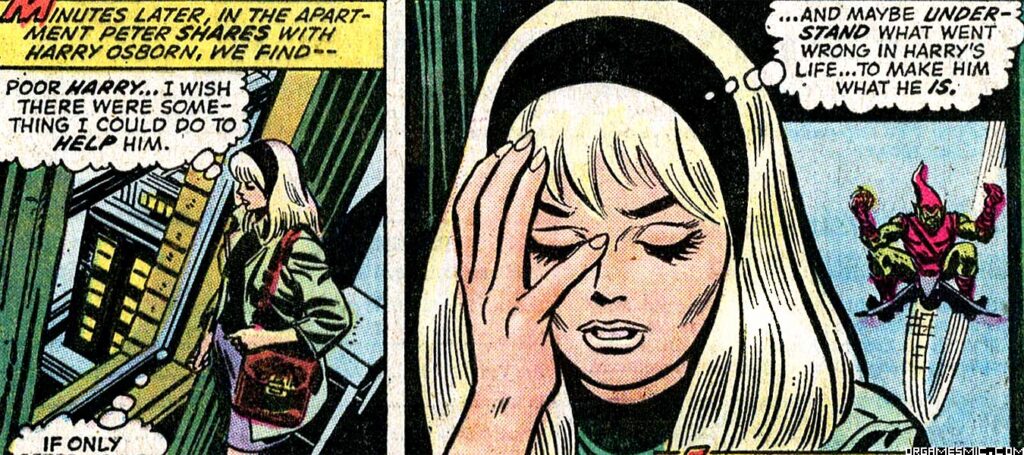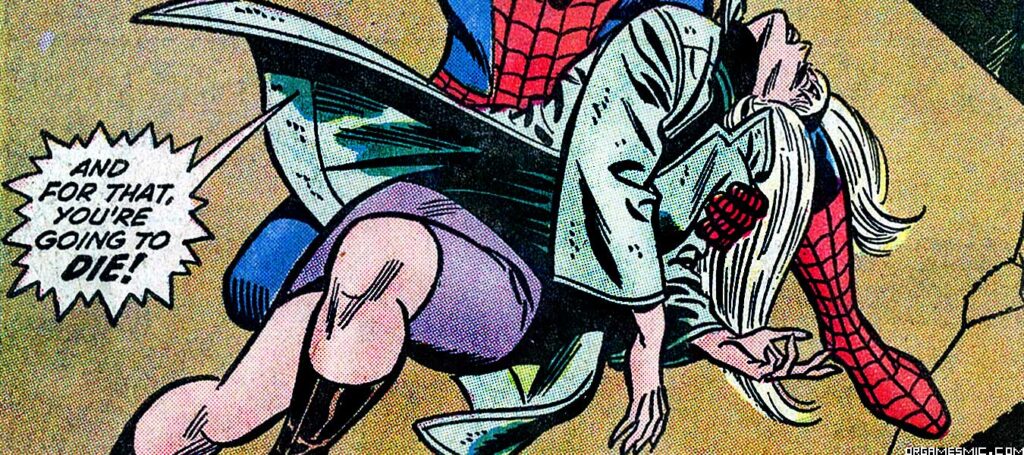This page may contain one or more affiliate links, which means that if you purchase a product through that link, I may receive compensation. The links will be identified with the text "affiliate link". Click to learn more.
Gwen Stacy’s death is perhaps ones one of the saddest and most notable deaths in comic book history. Once Peter Parker’s longtime girlfriend, her sudden and tragic death changed the course of Amazing Spider-Man and shocked readers. Even Stan Lee himself discusses this unexpected outcome in an interview with Kevin Smith. But how did Gwen Stacy die, and why is it significant?
In The Comics
To find the answer we must turn to Amazing Spider-Man 121. The issue starts with Harry Osborn in a bed while at home, ill from drug abuse. Mary Jane and Gwen Stacy are both visiting him. Peter attempts to visit as well but Norman Osborn, Harry’s father, catches him outside Harry’s door and makes it clear that he is not welcome in his home. Peter thinks about Norman Osborn being the villain The Green Goblin but has amnesia preventing him from remembering. After leaving we see Norman on the phone and his company’s stock continues to decline another thirteen percent, which makes him angry with beads of sweat on his forehead.
Unfortunately Norman Osborn suddenly remembers that he is The Green Goblin and because he blames Peter for what happened to him and his son, he decides that Spider-Man must die. Gwen waits for Peter to come back to his apartment while we see The Green Goblin from outside the window approaching from his flying glider. Meanwhile Spider-Man is sick due to the cold climate while he was in Canada, and this is effecting his focus and balance while web-slinging. He goes to his apartment and sees that Osborn took his girlfriend. He uses his spider-sense to find The Green Goblin on the top of The George Washington Bridge in New York City. This is when we begin to find out how Gwen Stacy passed away.
Spider-Man approaches and The Green Goblin basically tells Spider-Man to kill himself or else his girlfriend bites the dust. Since Peter is sick and has a bad sense of balance, he decides to cut the fight short by grabbing his enemy with his web shooter and with all of his spider-strength he pulls him toward him and punches him with everything he has. Goblin falls toward the Hudson River but uses his remote-controlled flyer to recover. Spider-Man thinks his best bet is to pick up Gwen and run. She seems to be in a state of shock. The Goblin flies by and whacks her off the bridge toward the water. Spider-Man tries to use his web-shooter to catch her and manages to get her leg. Unfortunately, her suddenly stopping in mid air caused her head to swing back and her neck to snap, therefore killing her. This is how Gwen Stacy dies.
The Green Goblin returns on his glider and calls Spider-Man a romantic idiot. He explains that she was dead before his webbing reached her, and a fall from that height would have killed anyone before they struck the ground. Spider-Man holds his fist in the air while cradling Gwen Stacy’s body with his other hand. He says that he killed the woman that he loved, and for that he is going to die. So it is clear that the Green Goblin accomplished his goal in emotionally hurting Spider-Man.
Gwen Stacy’s death is historically significant in comic books because it was not often when recurring characters would die, and her death was sudden. She was significant because she was Peter Parker’s first true love, and the most influential relationship in his life. If you love Spider-Man comics you should try to collect this issue (Affiliate Link), however it’s very pricey due to its popularity.
On The Big Screen

The death of Gwen Stacy in the movie Amazing Spider-Man 2 was a moment that left many fans in tears. It was a pivotal moment that not only affected Peter Parker, but also the entire audience. The way it was portrayed on screen was heart-wrenching and left a lasting impact. However, for those who were familiar with the comic book version of Gwen’s death, there were noticeable differences between the two.
In the movie, her demise occurs during a battle between Spider-Man and the Green Goblin on a clock tower. In the midst of the confrontation, Gwen falls from the clock tower and is caught by Spider-Man’s webbing. As she is being pulled up to safety, the Green Goblin interferes, causing her to fall again. This time, Spider-Man is not able to save her in time and she hits the ground, resulting in her death.
The scene is shot in slow motion, adding to the emotional impact. The use of the whiplash effect as she hits the ground further emphasizes the brutal nature. This scene is a departure from the comic book version, where it occurs on a bridge and is caused by the Green Goblin’s attack.
In the comics, the Green Goblin throws Gwen off the George Washington Bridge. As she falls, Spider-Man tries to save her by catching her with his webbing. However, in a tragic twist of events, the sudden stop from the webbing snaps her neck, resulting in her death. This version is often cited as one of the most iconic and heart-wrenching moments in Spider-Man’s history.
One of the biggest differences between the movie and comic book versions of Gwen’s death is the involvement of the Green Goblin. In the movie, the Green Goblin is directly responsible for what happened, while in the comics, he indirectly causes it. This difference adds a layer of personal vendetta for Spider-Man in the movie, as he must now avenge the death of his love.
Another notable difference is the setting of the scene. In the movie, Gwen falls from a clock tower, while in the comics, she falls from a bridge. The clock tower setting adds a sense of urgency and danger, as the characters are fighting at a great height. It also adds to the emotional impact, as what happened to her is witnessed by many people on the ground.
Additionally, the use of the webbing in the movie differs from the comic book version. In the movie, Spider-Man is able to catch Gwen with his webbing, but is unable to save her from the Green Goblin’s interference. In the comics, the sudden stop from the webbing is what causes her demise. This difference may have been made to give Spider-Man a sense of hope in the movie, as he almost succeeds in saving Gwen.
Despite these differences, both versions are equally tragic and impactful. The movie’s version stays true to the essence of the comic book version while adding its own unique elements. It also adds a personal touch by having the Green Goblin directly responsible for what happened to her.
Gwen Stacy’s death in the movie Amazing Spider-Man 2 is a heart-wrenching and pivotal moment that differs from the comic book version in certain aspects. However, both versions leave a lasting impact on the audience and serve as a reminder of the sacrifices that come with being a superhero.
In conclusion, Gwen Stacy’s death is a pivotal moment in the Spider-Man universe, forever changing the trajectory of the beloved character. As fans eagerly await the release of the upcoming Spider-Man film, ‘No Way Home’, we cannot help but reflect on the events of ‘The Night Gwen Stacy Died’ and the impact it has had on the franchise. From the infamous Amazing Spider-Man #125 where Spider-Man shoots his web, unknowingly causing Gwen’s death, to the Clone Conspiracy storyline where she is brought back to life, only to be killed again, Gwen’s fate has been a source of controversy and heartache for fans. And while Andrew Garfield’s iteration of Spider-Man may have saved Gwen in his origin story, in the end, she remains dead, no more.



